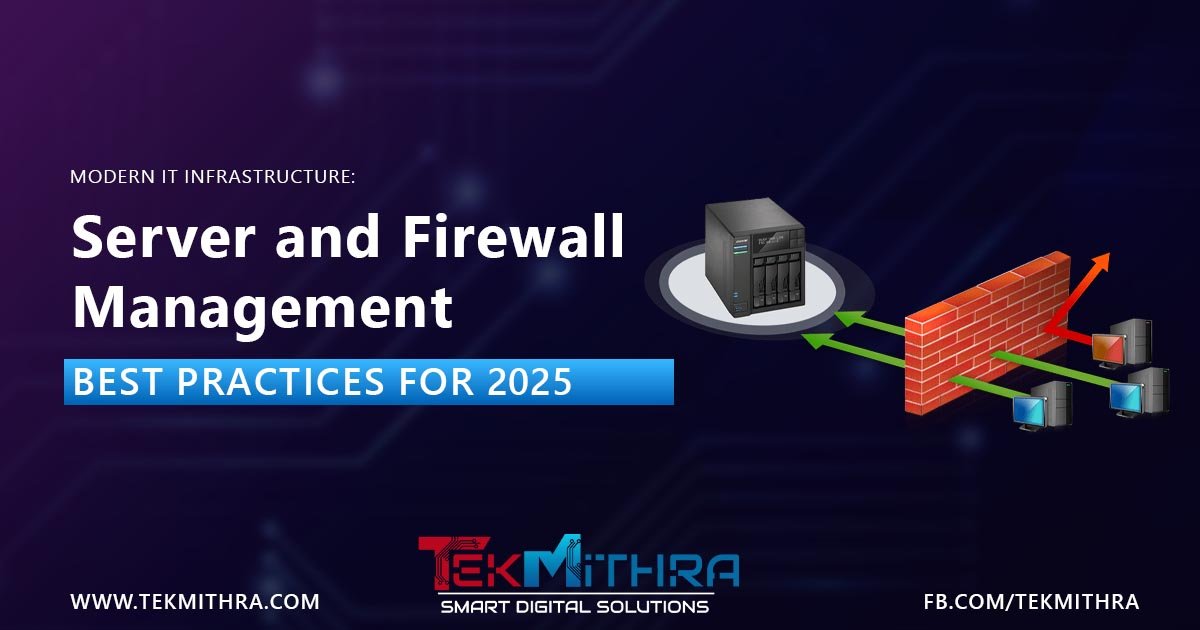
In the rapidly evolving landscape of IT infrastructure, server and firewall management has become a cornerstone of robust cybersecurity and efficient digital operations. Whether you’re managing a small business network or a sprawling enterprise cloud environment, understanding how to secure, monitor, and optimize your servers and firewalls is critical.
In this blog post, we’ll walk through the essentials of managing servers and firewalls, explore best practices, discuss common challenges, and provide actionable tips to enhance your IT security posture in 2025.
Table of Contents
Why Server & Firewall Management Matters
Servers host your applications, websites, databases, and digital services. Firewalls, on the other hand, are the gatekeepers of your network, controlling what traffic can enter or leave. Mismanagement of either can lead to downtime, data breaches, or performance bottlenecks.
Key benefits of effective server and firewall management:
- Enhanced network security and threat mitigation
- Performance optimization and reduced latency
- Improved system reliability and uptime
- Easier compliance with standards like GDPR, HIPAA, or PCI-DSS
1. Fundamentals of Server Management
Types of Servers to Manage
- Web Servers (e.g., Apache, Nginx)
- Application Servers (e.g., Tomcat, Node.js)
- Database Servers (e.g., MySQL, PostgreSQL)
- File Servers (e.g., Samba, FTP)
- Virtual/Cloud Servers (e.g., AWS EC2, Azure VMs)
Key Aspects of Server Management
a. Server Configuration
Proper setup ensures that the server is optimized for performance and security. This includes:
- OS installation and hardening (Linux, Windows Server)
- User access control and SSH key setup
- Service and port configuration
b. Monitoring & Logging
Continuous monitoring helps detect anomalies in real-time.
- Use tools like Nagios, Prometheus, or Zabbix
- Enable detailed logging (e.g.,
syslog, journald)
c. Updates and Patch Management
Outdated software is a major security risk.
- Automate OS and application updates
- Test patches in staging before production rollout
d. Backup & Disaster Recovery
- Implement automated daily backups (e.g., rsync, Veeam)
- Verify restoration procedures through periodic drills
2. Firewall Management Essentials
What is a Firewall?
A firewall is a network security system that monitors and controls incoming and outgoing network traffic based on predetermined rules.
Types of Firewalls
- Network Firewalls (hardware or software-based)
- Web Application Firewalls (WAF)
- Host-Based Firewalls (e.g., UFW, firewalld)
- Cloud Firewalls (e.g., AWS Security Groups)
Best Practices for Firewall Configuration
a. Default-Deny Policy
Block all incoming traffic by default, only allow what’s necessary.
b. Least Privilege Access
Restrict access based on need; avoid opening full port ranges unnecessarily.
c. Segment Your Network
Use VLANs or subnetting to separate critical systems from public-facing services.
d. Logging and Alerting
Track connection attempts, blocked traffic, and possible port scans.
e. Rule Maintenance
- Regularly review and clean up old firewall rules
- Document each rule’s purpose
3. Automation & Tools for Scalable Management
In modern DevOps and hybrid cloud environments, automation is no longer optional.
Server Management Tools
- Ansible, Puppet, Chef – Infrastructure as Code (IaC)
- Cockpit – Web-based server manager
- cPanel / Plesk – GUI control panels for hosting servers
Firewall Management Tools
- pfSense, OPNsense – Open-source firewall solutions
- AWS Firewall Manager – For cloud-native deployments
- Firewalld + Ansible – Automate Linux firewall configs
Centralized Dashboards
Consider SIEM tools like Splunk, Graylog, or ELK Stack for integrated log analysis and incident response.
4. Security Considerations in 2025
With growing threats like AI-powered attacks, supply chain vulnerabilities, and zero-day exploits, firewall and server management must evolve.
Emerging Best Practices
- Zero Trust Architecture (ZTA): Trust nothing by default, verify everything.
- AI-Powered Threat Detection: Use ML-based tools for anomaly detection.
- Regular Security Audits & Penetration Testing
- Multi-Factor Authentication (MFA) for all remote logins
5. Common Mistakes and How to Avoid Them
| Mistake | Consequence | Solution |
|---|---|---|
| Ignoring updates | Vulnerabilities | Use automated patching |
| Overly permissive firewall rules | Exposes network | Apply least privilege |
| No monitoring | Blind to threats | Implement alerting systems |
| Weak access control | Unauthorized access | Use SSH keys, MFA, RBAC |
| No documentation | Hard to maintain | Maintain change logs and wikis |
Conclusion
Managing servers and firewalls effectively is both a technical and strategic challenge in 2025. With increasing demands for uptime, scalability, and security, organizations must adopt best practices, utilize automation, and stay ahead of threats.
Whether you’re a system admin, DevOps engineer, or cybersecurity lead, investing time in proactive server and firewall management will pay dividends in reduced downtime, lower risk, and greater peace of mind.





